

The Russian Woodpecker of Chernobyl: How To See Over The Horizon. Pavlovsk Experimental Station. Vostok and Soyuz landing site monuments - collectSPACE: Messages. Maps. Monument to the Conquerors of Space. Monument as observed against the sun on a bright spring day.
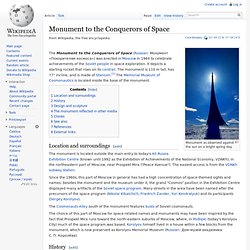
Coordinates: 55°49′22″N 37°38′24″E / 55.82278°N 37.64000°E / 55.82278; 37.64000 The Monument to the Conquerors of Space (Russian: Монумент «Покорителям космоса») was erected in Moscow in 1964 to celebrate achievements of the Soviet people in space exploration. It depicts a starting rocket that rises on its contrail. Cosmonaut Crashed Into Earth 'Crying In Rage' : Krulwich Wonders... Editor's Note, Updated April 24, 2012: We received many comments and questions on this post, which you can read here.
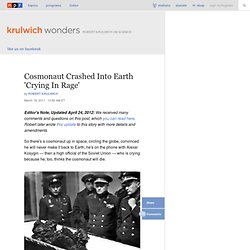
Robert later wrote this update to this story with more details and amendments. So there's a cosmonaut up in space, circling the globe, convinced he will never make it back to Earth; he's on the phone with Alexei Kosygin — then a high official of the Soviet Union — who is crying because he, too, thinks the cosmonaut will die. hide captionVladimir Komarov's remains in an open casket RIA Novosti/Photo Researchers Inc. Lost Cosmonauts. Lost Cosmonauts, or Phantom Cosmonauts, is a conspiracy theory alleging that Soviet cosmonauts entered outer space, but without their existence having been acknowledged by either the Soviet or Russian space authorities.
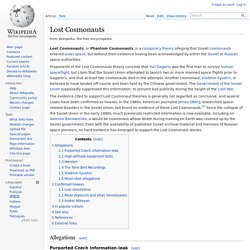
Proponents of the Lost Cosmonauts theory concede that Yuri Gagarin was the first man to survive human spaceflight, but claim that the Soviet Union attempted to launch two or more manned space flights prior to Gagarin's, and that at least two cosmonauts died in the attempts. Another cosmonaut, Vladimir Ilyushin, is believed to have landed off-course and been held by the Chinese government. The Government of the Soviet Union supposedly suppressed this information, to prevent bad publicity during the height of the Cold War. The evidence cited to support Lost Cosmonaut theories is generally not regarded as conclusive, and several cases have been confirmed as hoaxes.
Allegations[edit] 5 Soviet Space Programs That Prove Russia Was Insane. The thing about the Iron Curtain is that we'll never fully know what crazy shit went on behind it during the Cold War.

And that's too bad, because the little hints that leak out really make it look like these people just did not give a shit. Take the Soviet space program. We know they were the first to get both a satellite and a human in orbit, which were both pretty admirable accomplishments. What they kept hidden from the world was that maintaining even minimal levels of safety was a completely foreign concept to them. And that the cosmonauts who flew their rickety ass spaceships must have had balls made of elephant tusks. Yuri Gagarin. Gagarin became an international celebrity, and was awarded many medals and titles, including Hero of the Soviet Union, the nation's highest honour.
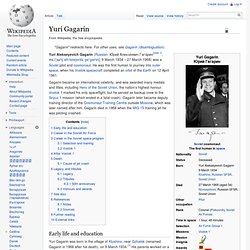
Vostok 1 marked his only spaceflight, but he served as backup crew to the Soyuz 1 mission (which ended in a fatal crash). Gagarin later became deputy training director of the Cosmonaut Training Centre outside Moscow, which was later named after him. Gagarin died in 1968 when the MiG-15 training jet he was piloting crashed. Early life and education Yuri Gagarin was born in the village of Klushino, near Gzhatsk (renamed Gagarin in 1968 after his death), on 9 March 1934.[1] His parents worked on a collective farm:[2] Alexey Ivanovich Gagarin as a carpenter and bricklayer, and Anna Timofeyevna Gagarina as a milkmaid. Alexey Leonov. Alexey Arkhipovich Leonov (Russian: Алексе́й Архи́пович Лео́нов, IPA: [ɐlʲɪˈksʲej ɐˈrxʲipəvʲɪtɕ lʲɪˈonəf]; born 30 May 1934 in Listvyanka, West Siberian Krai, Soviet Union) is a retired Soviet/Russian cosmonaut and Air Force Major General.
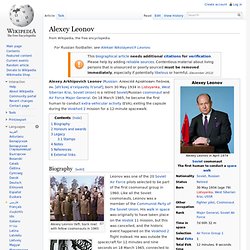
Star City, Russia. Coordinates: Star City (Russian: Звёздный городо́к, Zvyozdny gorodok[1]) is a common name of an area in Moscow Oblast, Russia, which has since the 1960s been home to the Yuri Gagarin Cosmonaut Training Center (GCTC).
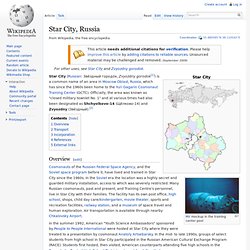
Officially, the area was known as "closed military townlet No. 1" and at various times had also been designated as Shchyolkovo-14 (Щёлково-14) and Zvyozdny (Звёздный).[2] Mir mockup in the training center pool Overview[edit] Cosmonauts of the Russian Federal Space Agency, and the Soviet space program before it, have lived and trained in Star City since the 1960s. In the summer 1992, American "Youth Science Ambassadors" sponsored by People to People International were hosted at Star City where they were treated to a presentation by cosmonaut Anatoly Artsebarsky.
First dog in space died within hours. The dog Laika, the first living creature to orbit the Earth, did not live nearly as long as Soviet officials led the world to believe. The animal, launched on a one-way trip on board Sputnik 2 in November 1957, was said to have died painlessly in orbit about a week after blast-off. Now, it has been revealed she died from overheating and panic just a few hours after the mission started.
Laika. Domesticated silver fox. The result of over 50 years of experiments in the Soviet Union and Russia, the breeding project was set up in 1959[1] by Soviet scientist Dmitri Belyaev.

It continues today at The Institute of Cytology and Genetics at Novosibirsk, under the supervision of Lyudmila Trut. Initial experimentation[edit] In a time when centralized political control exercised over genetics and agriculture was an official state doctrine, known as Lysenkoism, Belyaev's commitment to classical genetics had cost him his job as head of the Department of Fur Animal Breeding at the Central Research Laboratory of Fur Breeding in Moscow in 1948.[2] During the 1950s, he continued to conduct genetic research under the guise of studying animal physiology.